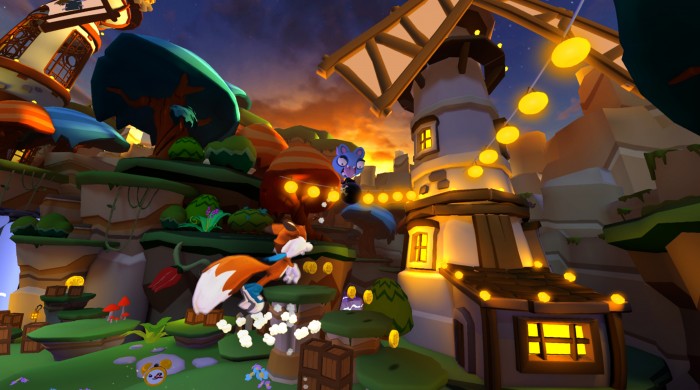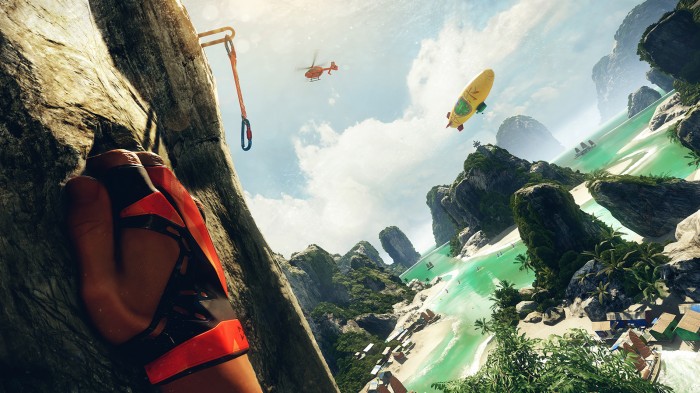Fun (and Some Nausea) with the First Games for the Oculus Rift Headset
There are plenty of things you might want to try in virtual reality. For many people, playing immersive 3-D video games is at the top of their list.
When Oculus starts shipping its first consumer virtual-reality headset, Rift, to buyers on March 28, 30 games will be released, too, ranging from futuristic shooting games to sports simulations to cartoony platform games. I tried out a number of them Tuesday.

Overall, I was impressed by the breadth of the different gaming experiences on offer, and by how well the games’ developers had adapted themselves to virtual reality. Making a compelling game involves visual, navigation, and interaction challenges that simply don’t exist for conventional flat screens. To make it harder still, you also have to worry about not making people nauseous, an unfortunate side effect of virtual reality for some of us.
The best of the games I played was Lucky’s Tale, which will be bundled with the Rift at the headset’s release date. It’s a platform game that has been compared to Super Mario Bros., which makes sense given its somewhat similar plot: you play as the title character, an adorable little cartoon fox named Lucky, who’s on a mission to rescue his porcine friend, Piggy, from a tentacled villain named Glorp.

The game is played so that you get the feeling that Lucky is quite small—like a doll whose world you are looking down on from above and, at times, a side view. It was relatively easy to control Lucky with the standard Xbox console controller that will be bundled with the Rift, as I ran around picking up coins and swiping my tail at bad guys who looked like obese caterpillars. The setting is lush and brightly colored, with lots of flowers, grass, trees, and rocks to run around and jump on.
Part of what makes the game so engaging in virtual reality are little touches that let me feel like I could actually interact with Lucky’s world, by taking advantage of the way the Rift tracks your head movements. While I had no physical body in the game, if I lifted my head up while guiding Lucky over a lantern-lit bridge, for instance, I could knock the lantern out of position. Similarly, if I leaned in toward Lucky at any time, he’d do things like look at me quizzically or wave.
A rock-climbing title called The Climb is very different but also enjoyable. At first it seemed like a horrible idea. I stood on a mat wearing a Rift headset and holding an Xbox controller. All I could see was a virtual pair of hands to represent my position in virtual space, and I was instructed to scale the cliffs overlooking a tranquil coastline modeled after Vietnam’s Ha Long Bay.

It was tricky to figure out where to place each hand, especially when the holds were small and obscured by brush growing out of the cliff walls. Having to occasionally leap to reach a hold that was too far away to just grab, with only my hands to give me a sense of where I was on the cliff, was strange. Not surprisingly, I fell a lot, and each time I had to start over at the last checkpoint I’d passed.
But once I started to get the hang of using the Rift’s head tracking and the controller’s buttons to move from one handhold to the next—at times, I really had to stretch up on the tips of my toes—and remembering to apply virtual chalk to my fingers and palms occasionally to keep my grip, I really liked the challenge.
Games for Oculus Rift will be rated according to their comfort level, an estimate of how likely it is that they’ll make you nauseous. That’s an approach already used in the game store for Samsung’s smartphone-based Gear VR headset. It makes it a little easier to guess whether a game or other virtual experience is worth your time and money.
Lucky’s Tale and The Climb are rated “moderate” by Oculus. I felt totally comfortable with the former, but there were a few moments when I felt nauseous while playing The Climb.

That was nothing compared to the waves of sickness that washed over me when I took the virtual wheel of a race car in a game called Project Cars, which will cost $50 when it launches on March 28. The game is rated “intense” for good reason. I’m not an impressive driver in real life, but in virtual reality I’m horrible. I found myself swerving all over the road, smacking into guardrails, and quickly felt like I wanted to hurl.
It didn’t help that the game includes realistic weather conditions. I was racing a course that took place on a country road in Scotland that was, apparently, prone to sudden downpours. Once the rain started coming down, it was harder to see, and the roads became increasingly slippery—hence, more swerving, bumping, and nausea. I lasted about 10 minutes before I had to take off my headset.
Fortunately, this kind of intense discomfort wasn’t the norm, and there will be plenty of non-racing games available to play with Rift when it comes out. I’ll be sticking with those for now.
Keep Reading
Most Popular
Large language models can do jaw-dropping things. But nobody knows exactly why.
And that's a problem. Figuring it out is one of the biggest scientific puzzles of our time and a crucial step towards controlling more powerful future models.
The problem with plug-in hybrids? Their drivers.
Plug-in hybrids are often sold as a transition to EVs, but new data from Europe shows we’re still underestimating the emissions they produce.
How scientists traced a mysterious covid case back to six toilets
When wastewater surveillance turns into a hunt for a single infected individual, the ethics get tricky.
Google DeepMind’s new generative model makes Super Mario–like games from scratch
Genie learns how to control games by watching hours and hours of video. It could help train next-gen robots too.
Stay connected
Get the latest updates from
MIT Technology Review
Discover special offers, top stories, upcoming events, and more.